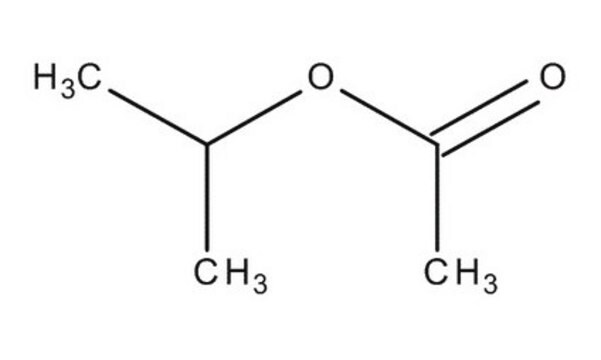112992
Isopropyl acetate
98%
Synonym(s):
Acetic acid isopropyl ester
About This Item
Recommended Products
vapor density
3.5 (vs air)
vapor pressure
47 mmHg ( 20 °C)
Assay
98%
form
liquid
autoignition temp.
894 °F
expl. lim.
1.8 %, 37 °F
8 %
greener alternative product characteristics
Safer Solvents and Auxiliaries
Learn more about the Principles of Green Chemistry.
sustainability
Greener Alternative Product
refractive index
n20/D 1.377 (lit.)
bp
85-91 °C (lit.)
mp
−73 °C (lit.)
density
0.872 g/mL at 25 °C (lit.)
greener alternative category
, Aligned
SMILES string
CC(C)OC(C)=O
InChI
1S/C5H10O2/c1-4(2)7-5(3)6/h4H,1-3H3
InChI key
JMMWKPVZQRWMSS-UHFFFAOYSA-N
Looking for similar products? Visit Product Comparison Guide
General description
Application
Signal Word
Danger
Hazard Statements
Precautionary Statements
Hazard Classifications
Eye Irrit. 2 - Flam. Liq. 2 - STOT SE 3
Target Organs
Central nervous system
Supplementary Hazards
Storage Class Code
3 - Flammable liquids
WGK
WGK 1
Flash Point(F)
41.0 °F - closed cup
Flash Point(C)
5 °C - closed cup
Certificates of Analysis (COA)
Search for Certificates of Analysis (COA) by entering the products Lot/Batch Number. Lot and Batch Numbers can be found on a product’s label following the words ‘Lot’ or ‘Batch’.
Already Own This Product?
Find documentation for the products that you have recently purchased in the Document Library.
Customers Also Viewed
Our team of scientists has experience in all areas of research including Life Science, Material Science, Chemical Synthesis, Chromatography, Analytical and many others.
Contact Technical Service













